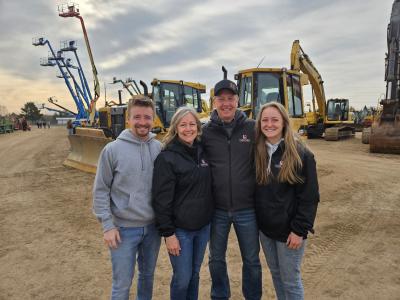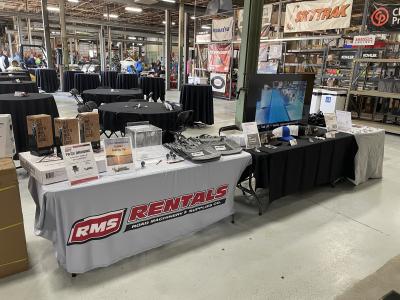The current project to replace a southwestern Pennsylvania bridge carrying US Route 40 over the Youghiogheny Reservoir raises memories of a span constructed almost 200 years ago — a bridge that still emerges occasionally from beneath the water that drowned a score of local villages during the 1940s.
The First Two Bridges
The original Great Crossings Bridge was 40 ft. (12.2 m) high and 30 ft. (9.1 m) wide. Built between 1815 and 1818, it was constructed as part of the National Road project, which began in 1811 and was designed to connect eastern rivers to the Ohio River.
At the time, Somerfield in Somerset County on the eastern side of the Youghiogheny River was a very small settlement, boasting only two streets and a handful of alleys. James Kinkead, Evan Evans and James Beck (the contractors and architects of all the National Road bridges) spent three years in Somerfield, overseeing construction of the bridge. It featured round buttresses with three arches of varying lengths and was built from sandstone cut locally.
The Great Crossings Bridge was formally dedicated on July 4, 1818, at a ceremony attended by President James Monroe and several members of his cabinet. Its opening ushered in a prosperous era for Somerfield, particularly as James Kinkead had built a stagecoach stop with a tavern (The Youghiogheny House) in the settlement.
However, the rise and fall of the stagecoach lines and later the advent of the railroad, which took much of the traffic passing through the area as was the case elsewhere in the country, meant the town flourished and then fell into decay more than once. Eventually Somerfield’s 1940s population of less than 200 residents was dispersed by its demolition (along with nine other local villages) to permit the Army Corps of Engineers to construct the reservoir dam.
Ironically, the necessary survey for the $9-million job was announced at a meeting in The Cornish Arms, the renamed tavern built by Kinkead.
Work on the existing structure began in 1939, while the dam was still being built. However, in 1941 the need for steel for war work stopped construction of this second bridge although the dam was completed to protect downstream industrial areas and railroads. By the time work resumed on the bridge, its design had been changed, as is shown by its mismatched pier columns, which, since the structure was built on solid ground, are set on footers. This second bridge was finally finished in l948, five years after completion of the dam.
The original Great Crossings Bridge is now under the aegis of the Archaeological Protection Act of 1974. It occasionally reappears during periods when the reservoir is low, such as during the 1991 and 1999 droughts and twice in the mid 1950s. When the 1991 drought caused the reservoir to be drained to keep rivers navigable and water supplies replenished, the ruins of Somerfield became visible again for a short time and drew thousands of visitors, including former residents.
In 1940, the dedication stone of the Great Crossings Bridge, inscribed with the names of its builders and displayed on its parapet, disappeared. It had been taken by a local resident, doubtless to keep it safe from the forthcoming inundation. Recovered in the late 1980s, the stone was installed at a location on U.S. Route 40, the main street of nearby Addison Township. Similarly, when the first bridge re-emerged for a time in 1991 souvenir hunters made away with a number of parapet stones.
Challenging Project
The prime contractor for the project is G. A. & F. C. Wagman Inc., headquartered in York, PA.
Straddling the Pennsylvania-Maryland border, the Youghiogheny River reservoir is approximately 16 mi. (25.7 km) long. Although popular with boaters and fishermen interested in landing trout, walleye, perch, and other species, the reservoir’s primary use is flood control. Thus the water level can fluctuate by as much as 40 ft. over the course of the year, with a pool size ranging from 2,840 acres up to 3,556 acres. Its average depth is 54 ft. while, since it is capable of holding the equivalent of 11 in. of run-off from 434 sq. mi. of land, its maximum depth is 121 ft. Because of this, cofferdams were ruled impractical.
The 1,730-ft.-long (527.3 m) and 47-ft.-wide (14.3 m) steel girder structure is being built parallel to the current span, with its southern face approximately 5 ft. away from the northern side of the existing bridge — indeed, at one point part of its deck had to be cut away in order to allow construction to proceed unimpeded.
The project was originally planned as a rehabilitation job but the bridge was found to be un-repairable. Work on the $25.4-million replacement began in October 2003, with funding provided by the Federal Highway Administration (FHA) and the Pennsylvania Department of Transportation (PennDOT). A groundbreaking ceremony was held on Nov. 13, 2003 and despite some delay caused by the late thaw in spring 2004 the job is on schedule for its estimated completion date of mid February 2006.
Construction Carried Out in Four Stages
Phase I has been completed and saw temporary widening of the southern approach to the existing structure as well as erection of the substructure.
Phase II is currently under way and covers embankment widening on both sides of the reservoir, as well as completion of the new bridge.
Phase III will include demolition of the existing span, whose piers are to be collapsed into the reservoir so fish can live in its nooks and crannies.
Phase IV sees the final paving of the approaches, plus reconfiguration of an intersection to the east of the reservoir. After completion of this final phase, the US Army Corps of Engineers will turn the work base on the eastern side into either an interpretive area or a car park.
“At the moment [May] we are constructing the concrete bridge deck,” Anthony W. Bednarik, Wagman’s project manager said. “We’re using a Grove 28-ton hydraulic crane and will be using a Bidwell bridge deck finishing machine and rented concrete pumps. We currently have about 30 employees on the job. Last year we had about 50 working on it.
“We’ve completed the substructure, which was two abutments, 14 9-ft. diameter caissons, 14 8-ft. diameter pier columns and seven pier caps,” he said. “For the caissons we were using a Manitowoc 4100 for the caisson drill rig. We had a Manitowoc 2250 as one support crane with an American 9922 as the second. The drill rig and the two support cranes were floating on Robishaw engineering barges [Flexi floats]. Another American 9922 was used as a support crane on the dock and we engineered a steel template system to accommodate the lake’s fluctuations.”
While the bridge design calls for long spans to minimize the number of deep-water foundations required, the piers built during higher reservoir levels — as well as the necessary drilling, setting of the rebar cages and placement of concrete — involved construction in water between 40 ft. (12.2 m) and 80 ft. (24.4 m) deep. The bridge pier foundations were 9-ft. (2.7 m) diameter caissons drilled into bedrock. Concrete was placed by the tremie pour method, i.e., pouring concrete though a l0-in. (25.4 cm) diameter pipe underwater.
On the other hand, differences in water depths were used by the contractors in summer 2004 to facilitate concrete pouring for the columns, which was arranged to take place when the reservoir was at its highest level.
The majority of the shafts were drilled approximately 20 ft. (6.1 m) into the bedrock, but one had to be continued to approximately 60 ft. (18.3 m), passing through coal mine workings on the way. Rebar cages weighing 35 to 40 tons (31. 7 to 36.3 t) were built on site inside specially designed lifting racks and then transported by barge for placement.
The preliminary or technique caisson was tested by the Osterberg load procedure. Concrete consolidation was checked by cross sonic log testing whereby sensors sent and received ultrasonic pulses, measuring the integrity of the material by the time taken for pulses from one set of probes to arrive at their matching receiver probes.
“The Osterberg load test is used to verify the design parameters,” Bednarik said. “Based on tests conducted during design the engineer assumes the strength of the rock strata on which we are installing the caisson. With the Osterberg load cell and the sensors attached to the caisson at various locations the engineer is able to confirm the rock strength and determine the actual stresses felt by the caisson when it is loaded.
“On this project the Osterberg cell was loaded until the caisson failed,” he said. “The data from the Osterberg cell and the sensors in the caisson is sent to the design engineer for verification. With this information the final design can be adjusted to accommodate the actual strength of the rock strata.”
Some roadwork has now also been completed. “We used a Komatsu PC400 hoe to place large rip rap and a Caterpillar D6 dozer and 330 excavator to construct a staging area for the bridge work that had to be completed from barges,” Bednarik said.
Caisson drilling was handled jointly between Case Foundation Company Inc., based in Broomall, PA, and Richard Goettle Inc. of Cincinnati, OH.
Other subcontractors working on the job include Keystone Lime Company, headquartered in Springs, PA (paving); Interlock Steelworkers Inc., of Mt Airy, MD (rebar placement); and Karen Construction Company Inc., of Kutztown, PA (bridge deck plan).
Original design was by HDR Engineering Inc., of Pittsburgh, PA, and alternate design was provided by Gannett Fleming Inc., based in Harrisburg, PA. Structural steel was provided by High Steel Structures Inc., headquartered in Lancaster, PA.
U.S. Route 40, which follows what was once the route of the National Road, has many historically significant properties located along it and so has largely remained a two-lane highway, as is the case in this area. The new bridge will therefore feature only two 12 ft. (3.6 m) lanes with 10 ft. (3 m) shoulders. In addition, at the request of the National Road Heritage Corridor (NRNC), the new structure was designed to fit into its historic surroundings. To accomplish this, the upper part of the piers as well as wing walls, abutments, and the outer parapets of the new bridge will be architecturally treated so as to present the appearance of being constructed from cut stone, thus matching the material from which the Great Crossings Bridge was constructed.
Finally, the structure also will feature false steel arches erected between the piers to echo the arches of the Great Crossings Bridge. These false arches will painted to look like the material from which the original bridge was constructed, thus harking back visually to the first bridge built on this site almost two centuries ago.
About the Company
G.A. & F.C. Wagman Inc., is a highway and heavy construction company, which has been in business since 1902. Its projects have included bridges in Pennsylvania, Maryland and Delaware. Its current jobs include three contracts on the Woodrow Wilson Bridge project just outside Washington D.C. It also is in a joint venture for the bridge reconstruction carrying the PA turnpike across the Susquehanna River in Harrisburg, PA.
The job involves two segmental concrete bridges, the first of this type to be built in the Commonwealth. Wagman Inc.’s areas of expertise also include concrete overlay and piling. Company board chairman and CEO Richard Wagman was elected 2004-2005 chairman of the American Road & Transportation Builders Association (ARTBA). CEG
This story also appears on Crane Equipment Guide.
Today's top stories















